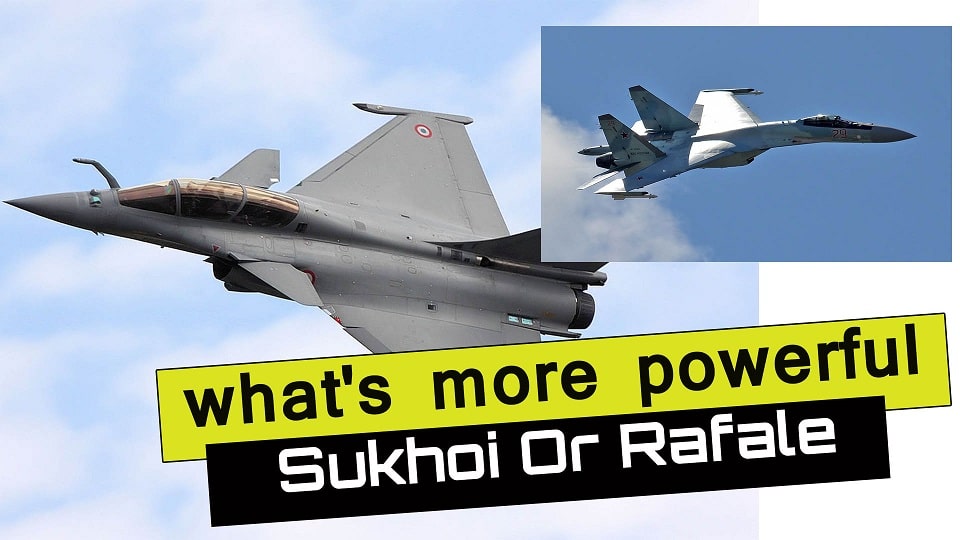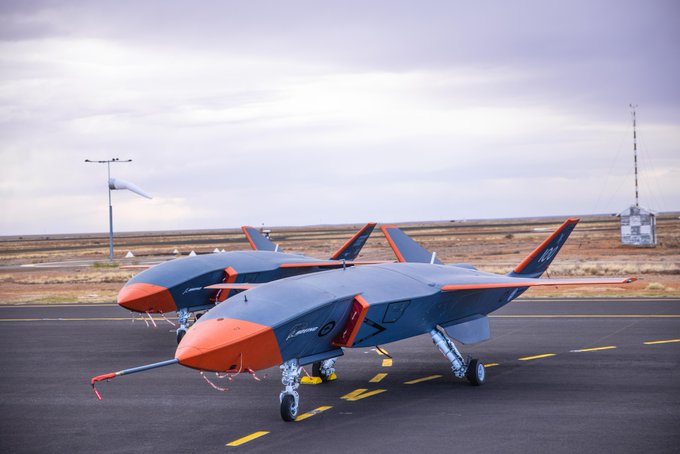Aerospace
How powerful is Rafale as compared to Russia’s Su-35S : Specification, Range and Cost.

We all enjoy seeing fighter jets because of their speed and fighting capabilities. It is critical for any country to defend its frontline as well as its adversaries. Most countries choose fighter jets for a variety of reasons, and we will compare two fighters in this article. One is a Dassault Rafale fighter plane, and the other is a Sukhoi Su35 fighter plane. Both are prepared for any adversity that may arise during the battle. Let’s see how powerful each of these aircraft is.
Rafale is a fifth-generation fighter aircraft constructed in France. It has a top speed of Mach 1.8, 14 hard points, and is equipped with 190 Kg missiles with a range of more than 100 kilometers.
It is armed with a 70-kilometer-range air-to-surface missile that can destroy everything within that range, and it is a 10-ton fighter jet with a take-off weight of 24.5 tonnes. Rafael has a range of 3700 kilometres. It has the ability to reach a height of 50,000 feet.
At higher altitudes, the Sukhoi Su-35S can reach Mach 2.25, which is comparable to the F-22 and faster than the F-35 or F-16. The Sukhoi Su-35S can fly at 60,000 feet, which is the same altitude as the F-15 and F-22 and 10,000 feet higher than the Super Hornet, Rafale, and F-35.
Sukhoi Su 35 is a variant of the Sukhoi Su 27 flanker. Su 35 has two thrust vectoring engines, which are similar to those employed in the F-22 Raptor, a Western aircraft. Su 35s may attack from a number of angles as a result of this.
Sukhoi Su-35S has a range of 2,200 miles with two external fuel tanks, or 2,800 miles with two external fuel tanks. This plane can reach a top speed of 2,390 kilometers per hour. Sukhoi Su-35S has a maximum take-off weight of 34,500 kg and a weight of approximately 18,400 kg.
In comparison to the F-15C and F-22, the Su 35 has twelve hard points for weapon attachment. It can detect its target from a distance of around 400 kilometers. Its radar, on the other hand, can track up to 30 objects at once. Because to its cutting-edge radar technology, the Sukhoi Su-35S can track up to four ground targets or 30 air targets at once.
The Rafale can carry out air-to-ground strikes, as well as air-to-air attacks and interceptions, in the same sortie thanks to its superior load-carrying capability and innovative mission system.
It can carry out multiple tasks at once, like as launching air-to-air missiles during a low-altitude penetration phase: a clear display of the Rafale’s genuine “Omnirole” capacity and exceptional survivability.
Due to the fact that Rafale aircraft are operated by “buddy-buddy” refueling missions can be carried out in areas of the airspace where dedicated and vulnerable tanker planes are unable to fly.
The SPECTRA system detects, identifies, and localizes threats at long distances, allowing the pilot to choose the most effective defensive actions based on a combination of radar jamming, infrared or radar decoying, and evasive maneuvers.
Thales’ new Talios targeting and laser designator pod gives the Rafale full day and night surveillance and laser designator capability with metric precision. It enables the delivery of laser-guided missiles at a stand-off range and altitude.
Airbus to showcase ‘Future of Flight’ at Dubai Airshow 2019
Any western fighter plane’s radar can be jammed by the Sukhoi Su 35 radar. There’s also an air to ground mode on the radar, which can detect up to four ground objects at once. Sukhoi claims that it has a fifty-mile range and is equipped with the OLS 35 ragetting system, which includes an infrared search and track system.
United Airlines orders 50 Airbus A321XLRs for transatlantic route expansion
Sukhoi is planned to serve as Russia’s primary fighter until the country’s 5th generation stealth fighter plane is completed. Despite the fact that the Sukhoi Su-35S is not a stealth fighter, it has helped Russia reclaim its status as a modern air force superpower.
Did you know these 10 incredible facts about Honda jet ?
A Su-35 is expected to cost roughly $85 million per unit, while the Rafale fighter is expected to cost more than US$110 million. Both aircraft have distinct options in terms of weapon packages and avionics modifications, so the price may rise even further.

Aerospace
Top 10 world’s best military drones in 2024

In an age defined by rapid technological advancement and strategic military innovation, the role of unmanned aerial vehicles, commonly known as drones, has become increasingly pivotal on the modern battlefield.
As we step into 2024, the global landscape of military drones continues to evolve, with nations investing heavily in cutting-edge technologies to maintain superiority in reconnaissance, surveillance, and combat operations.
Join us as we delve into the top 10 military drones that are shaping the future of warfare, showcasing their capabilities and impact on the ever-changing theater of conflict.
1. Boeing MQ-28 Ghost Bat :This aircraft represents a cutting-edge advancement in unmanned combat aerial vehicles, currently under development by Boeing Australia. As a Loyal Wingman class aircraft, it is engineered to seamlessly integrate with existing military aircraft, enhancing and extending airborne missions through its stealth capabilities and multirole functionality. With an impressive range surpassing 2,000 nautical miles and a combat radius of 900 miles, it promises to revolutionize aerial operations. Anticipated to join the ranks of the RAAF in 2024-25, these unmanned platforms herald a new era in military aviation.
2.The Bayraktar TB2: stands as a formidable medium-altitude long-endurance (MALE) unmanned combat aerial vehicle, crafted by the Turkish company Baykar. Renowned for its prowess, Bayraktar drones have found their way into the arsenals of numerous nations worldwide, seeing action in various conflicts including the Russian invasion of Ukraine and the Tigray War. Featuring a sleek blended wing body design complemented by an inverted V-tail structure, the TB2 platform exemplifies innovation in aerial technology. With an approximate price tag of 5 million US dollars per unit, it represents a significant investment in defense capabilities.
3. Bayraktar Kızılelma: A cutting-edge project by Turkish defense company Baykar, introduces a single-engine, low-observable, carrier-capable, jet-powered unmanned combat aerial vehicle. It boasts a sleek, supersonic airframe designed for reduced radar cross-section (RCS) and is outfitted with an advanced AESA radar system. Its operational combat radius spans 500 nautical miles. Weighing in at a maximum takeoff weight (MTOW) of 6,000 kilograms (13,200 lb), it reserves 1,500 kg for payload capacity. Already, two prototypes have been manufactured, with plans for operational deployment expected by 2025.
4. XQ-58 Valkyrie: is a cutting-edge unmanned flying machine (drone) built for the U.S. Air Force. Designed by Kratos Defense, this high-tech aircraft is like a silent wingman, following a manned fighter jet and carrying out various missions. These missions could include scouting ahead for dangers, providing extra firepower, or even acting as a decoy to protect the manned aircraft. It boasts a maximum range extending approximately 3,000 miles, with a hefty maximum launch weight capped at 6,500 pounds. This figure includes the capacity to accommodate up to 600 pounds within its internal payload bay and an additional 600 pounds beneath its wings.
5.TAI Aksungur: is a heavyweight drone built for the Turkish Armed Forces. Designed by Turkish Aerospace Industries, it boasts an impressive wingspan of 12 meters (39 feet) and can carry a significantly larger payload than its predecessor. The Aksungur’s central fuselage, housed beneath the wings, is the brain of the operation. The range of this drone extends to 6,500 kilometers and payload capacity is 750 kg. It carries all the avionics, camera systems, and sensors the drone needs to function. An additional camera mounted on the chin provides a clear view directly below the aircraft.
6.Hongdu GJ-11: It is Sharp Sword is a marvel of Chinese aviation technology. This unmanned aerial vehicle (UAV), also known as a drone, is designed for stealth and long-range combat missions. The Sharp Sword’s tailless flying wing design makes it difficult to detect on radar. Internally, it houses two weapon bays, allowing it to carry a variety of armaments for air-to-surface strikes.
While the exact engine remains unknown, reported specifications boast an impressive range of 2,485 miles (4,000 kilometers) and accommodates internal weapons bays capable of carrying payloads of up to 2,000 kilograms (4,400 lbs). This combination of stealth, firepower, and range makes the GJ-11 a significant player in modern aerial warfare.
7.Dassault Neuron: is a pioneering unmanned combat aerial vehicle (UCAV) built through a collaborative effort by European nations. This high-tech drone serves as a technological demonstrator, paving the way for future autonomous combat aircraft.
Designed for stealth and independent operation, the nEUROn is built to handle the toughest combat environments. With a sleek design measuring 10 meters long and 12 meters wide, it has an estimated unit cost of €25 million if a production version were built. The nEUROn’s demonstrator model weighs approximately 5 tons and showcases the potential for future European-built combat drones. It has capability to transport two laser-guided 250 kg bombs, each housed in its own weapon bay.
8.The Sukhoi S-70 Okhotnik-B: also known as Hunter-B, is a formidable unmanned combat aerial vehicle (UCAV) under development by Russia’s Sukhoi company. Designed to strike fear into the hearts of enemies, this high-tech drone is built for stealthy operation.
The Okhotnik-B boasts a flying-wing design, a favorite technique for minimizing radar detection. Its construction incorporates composite materials and special stealth coatings to further reduce its radar signature.Powering this aerial predator is an AL-31 turbojet engine, allowing it to reach estimated speeds of 1,000 kilometers per hour with a range of 6,000 kilometers.
9.The Northrop Grumman X-47B: is a groundbreaking unmanned combat aerial vehicle (UCAV) designed for launching and landing on aircraft carriers. This American marvel, developed by Northrop Grumman, is a tailless jet with a unique blended-wing-body design. This design helps it cut through the air efficiently. It can operate semi-autonomously, meaning it can fly pre-programmed missions with some human oversight.The X-47B can refuel in the air, extending its range for even longer missions at sea. The X-47B drone boasts an approximate range of 2,100 nautical miles.
10.CAIG Wing Loong II:
The Chengdu GJ-2, also known as the Wing Loong II, is a powerful unmanned aerial vehicle (UAV) built for long-range strikes. Developed by the Chengdu Aircraft Industry Group, this drone can be controlled remotely or fly autonomously using pre-programmed missions.
An upgrade from its predecessor, the Wing Loong I, II boasts a larger body and wider wingspan, allowing it to carry an impressive payload. This drone can pack a punch with up to 480 kilograms of laser-guided bombs and missiles. The manufacturer even claims it has the potential to carry air-to-air weaponry, making it a versatile threat in the skies.It can carry a maximum payload of 400 kilograms.
Aerospace
India is set to build a central command for the Air Traffic Control system, called ISHAN

India’s air traffic growth has led to increased responsibilities for air traffic control. The Airports Authority of India (AAI) is considering centralizing air traffic control for aircraft, dividing the country into four regions. The goal is to consolidate India’s segmented airspace into a single entity to improve air traffic management (ATM) efficiency, safety, and smoothness.
Recently, the AAI invited expressions of interest to develop a detailed project report for the Indian Single Sky Harmonized Air Traffic Management (ISHAN) initiative in Nagpur. Under this plan, air traffic controllers in Nagpur would handle domestic flights flying above 25,000 feet, eliminating the need for coordination among controllers in different regions.
For domestic regional flights operating above 25,000 feet, control would shift to the central command in Nagpur. This consolidation aims to enhance airline operations, increase flight handling capacity, and reduce congestion and flight times for passengers.
Currently, the AAI provides ATM services over Indian airspace and adjoining oceanic areas, covering over 2.8 million square nautical miles. This airspace is divided into four flight information regions (FIRs) in Delhi, Mumbai, Kolkata, and Chennai, along with a sub-FIR in Guwahati.
FIRs are responsible for providing air traffic services, including weather information, visibility, and search and rescue assistance. The proposed unification under the ISHAN initiative aligns with the projected growth of the aviation industry, which anticipates a doubling of domestic passenger traffic by 2030.
Aerospace
Does AirAsia show interest in Comac aircraft in the future?

Tony Fernandes, CEO of Capital A, operating as AirAsia Group, recently paid a visit to the facilities of COMAC on April 2, 2024, and was thoroughly impressed by what he witnessed.
C919 already securing nearly 1000 orders
COMAC, known for its homegrown aircraft, has launched two promising jets: the ARJ21 and the C919 aircraft. Both aircraft are gaining popularity in the Chinese market, with the C919 already securing nearly 1000 orders from various airlines.
Fernandes expressed his admiration for COMAC’s achievements in aircraft manufacturing, acknowledging the immense challenge it entails. His visit underscored the realization that AirAsia now has a viable third option when it comes to selecting aircraft for its fleet.
During his tour, Fernandes was delighted by the innovation and technology evident in COMAC’s aircraft production and the company’s commitment to long-term partnerships.
He noted that many Western companies have shifted away from prioritizing loyalty and customer service, opting instead for short-term gains and a narrow definition of success.
Last month, COMAC embarked on an international tour, showcasing demonstration flights to neighboring countries, particularly Indonesia and Malaysia. Fernandes believes that the positive impression left by COMAC during his visit opens up new opportunities for collaboration.
Fernandes emphasized COMAC’s remarkable achievements
The shared values of loyalty, customer service, and long-term vision align closely with AirAsia’s ethos, making collaboration with COMAC appealing. With a focus on innovation and excellence, both companies stand to benefit from a partnership grounded in trust and a shared commitment to success.
Indonesia and China have already collaborated in validating and maintaining the airworthiness of the ARJ21 aircraft, indicating a solid foundation for future partnerships.
In his statement, Fernandes emphasized COMAC’s remarkable achievements and genuine desire for long-term partnership, highlighting the absence of ego and a genuine willingness to succeed together. He marveled at COMAC’s fully automated, AI-driven factory, a testament to their dedication to innovation and efficiency.
Fernandes criticized Western firms for prioritizing short-term gains over loyalty, customer service, and long-term strategy, emphasizing the importance of understanding customers’ needs and collaborating to achieve success.























